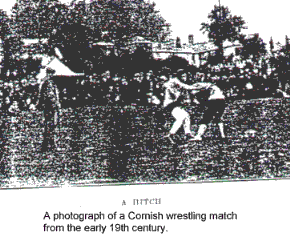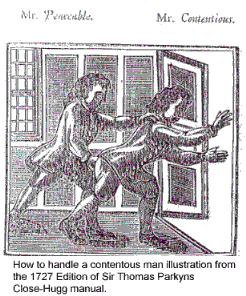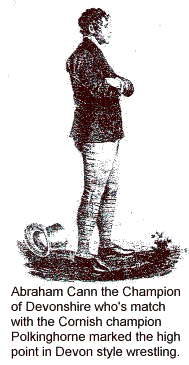Early Cornish Wrestling
By Ken Pfrenger
Editor's Note: Martial Artists
most often look to Asia as the source of many fighting
systems but forget that in Europe many weapon and
empty hand systems also flourished. Although many
differences exist, European fighting traditions employed
techniques similar to those found in both Japanese
judo and jujutsu, as well as those in modern Western
boxing and wrestling.
Origins and Early History
Very few western martial traditions have a verifiable
unbroken line of practice from Medieval times. The
same can be said for Asian martial traditions as well.
 The
indigenous wrestling of England's West Country and
of the Cornish people themselves has a history that
extends before Medieval times and possibly back into
ancient times as well. The
indigenous wrestling of England's West Country and
of the Cornish people themselves has a history that
extends before Medieval times and possibly back into
ancient times as well.
According to Cornish legends, around the year 1000
B.C. Corinaeus, the first chief of Cornwall, defeated
the giant named Gog Magog by throwing him into the
sea from Plymoth Hoe. Up until the Renaissance, figures
were caved into the sod of Plymoth Hoe depicting this
wrestling scene. Of course, this is only a legend,
and hardly a scholarly bit of evidence to suggest
a date for the origin of Cornish wrestling. However,
it does show the importance of wrestling to the Cornish
people by being included in the story of the founding
of their homeland.
A more concrete bit of evidence exists for an early
date for wrestling traditions in Cornwall and that
is the founding of the Celtic region now known as
Brittany. During the 4th and 5th centuries A.D., many
indigenous Britons from the areas now known as Cornwall
and Devonshire migrated to Cornouaille, in present
day Brittany. It is believed that they brought the
sports of wrestling and hurling with them. From an
early time until now, both these sports have remained
staples of Breton sportive traditions.
Wrestling was also a traditional combat sport in
other Celtic areas at this early time, as well. In
many of the Irish texts written from the 8th to 12th
centuries, wrestling between combatants before armed
combat is mentioned several times. It is also known
that Irish wrestlers traveled to Cornwall to compete
in the late Middle Ages. Irish collar-and-elbow wrestling
as practiced in the 19th century greatly resembled
the wrestling in Cornwall and the Breton wrestling(gouren).
This suggests an almost pan-Celtic style of wrestling
that may have had its origin in a time when the Celtic
peoples dispersed themselves over the British Isles.
This all said, it is important to note that the earliest
true evidence for wrestling in Cornwall comes from
a carved roof boss dated c. 1300 A.D., which depicts
two wrestlers gripping each other in the modern Cornish
manner. A similar carving can be found on the Market
Cross at Kells in Ireland dated c. 800 A.D.
The first written evidence for wrestling in the West
Country comes from a 1590 poem entitled "Polyolbion"
by Michael Drayton, concerning the Battle of Agincourt
in 1415. It states that the Cornish men who accompanied
Henry V into battle had a standard that depicted two
wrestlers. A replica of just such a banner is usually
flown at wrestling events in modern Cornwall.
In 1520, there is an account of a tournament between
the Cornish wrestlers of Henry VIII of England and
the Breton wrestlers of Francis I King of France being
held at Calais in France. The Cornish wrestlers won
the day, but king Henry VIII was thrown with a flying
mare during a challenge match with the French king.
There are several other references made to Cornish
wrestling in the 16th century, but most of them do
not get into any specifics.
In the 17th century, Sir Richard Carew wrote of Cornish
wrestling and its close relative, Devonshire wrestling
in his "Survey of Cornwall" He writes...
"Wrastling is as full of manliness, more delightful
and less dangerous (than hurling).... for you shall
hardly find an assembly of boyes in Devon and Cornwall,
where the most untowardly amongst them will not
as readily give you a muster of this exercise as
you are prone to require it."
Parkyns and After
 In
1713, a man by the name of Sir Thomas Parkyns wrote
the first manual entirely devoted to wrestling in
the English language, "The Inn-Play or Cornish-Hugg
Wrestler." Parkyns' Close-Hugg style differs
greatly from the modern sport of Cornish wrestling.
It is much more combative in nature, yet it does contain
some of the same throws such as the flying mare and
cross-buttock. It seems to not only deal with the
sportive aspects of the style, but also with self
defense as well. Defenses against lapel chokes and
several other attacks are included, as well as a section
about which of the Close-Hugg moves to use while boxing. In
1713, a man by the name of Sir Thomas Parkyns wrote
the first manual entirely devoted to wrestling in
the English language, "The Inn-Play or Cornish-Hugg
Wrestler." Parkyns' Close-Hugg style differs
greatly from the modern sport of Cornish wrestling.
It is much more combative in nature, yet it does contain
some of the same throws such as the flying mare and
cross-buttock. It seems to not only deal with the
sportive aspects of the style, but also with self
defense as well. Defenses against lapel chokes and
several other attacks are included, as well as a section
about which of the Close-Hugg moves to use while boxing.
There is also a small section on how to deal with
a contentious man, which shows the old bartender favorite
of grabbing a person by the collar and back of their
pants to escort them to the door.
Parkyns makes small mention of "out-play,"
which concentrated on the tripping and kicking aspects
of the sport, which he considered inferior to the
"in-play" of the Cornish style in the manual,
which relied on the upper body. There is only a small
mention of the jacket, which is used in the modern
style of Cornish wrestling and Devonshire. Interestingly,
the account by Carew in the 17th century does not
mention the jacket, but mentions a girdle that is
used for grips. Parkyns does not mention this girdle.
The girdle perhaps gives rise to a connection between
the Cornish style and another indigenous British style
known as side-hold, in which a harness is worn for
grips. By the 19th century, the use of the jacket
was standard, and a great rivalry had grown between
the wrestlers of Cornwall and Devonshire. The two
groups basically practiced the same form of wrestling,
but seemed specialize in different areas of the sport.
The Cornish men concentrated on the "in-play"
or "close hug," while the Devonshire wrestlers
concentrated on "out-play." Obviously, both
styles of wrestling contained the elements of the
"in-play" and "out-play" but held
a preference for one or a prejudice to the other.
The style of the Devonshire men was thought of as
brutal by the Cornish spectators due to the fact that
Devonshire matches often turned into punishing shin
kicking contests. Often shoes were worn in the Devonshire
style to add more damage to the kicking techniques,
while the Cornish wrestlers stayed barefooted or wore
wool socks.
 In
1826, a huge challenge match took place between the
Cornish Champion Polkinghorne and the Devonshire Champion,
Abraham Cann. Cann was permitted to wear one shoe
and was said to have kicked mightily on that day.
It is unclear who won that match, with the judges
calling it a draw and the spectators from the various
camps claiming victory for their sides. However, the
style of Devonshire seemed to be losing steam by this
time. Within a century, it was all but forgotten,
while the Cornish style today hangs on by a slender
thread. However, the art is kept alive today by a
growing interest in western martial traditions and
through continued practice by dedicated Cornish wrestlers
at fairs and tournaments. In
1826, a huge challenge match took place between the
Cornish Champion Polkinghorne and the Devonshire Champion,
Abraham Cann. Cann was permitted to wear one shoe
and was said to have kicked mightily on that day.
It is unclear who won that match, with the judges
calling it a draw and the spectators from the various
camps claiming victory for their sides. However, the
style of Devonshire seemed to be losing steam by this
time. Within a century, it was all but forgotten,
while the Cornish style today hangs on by a slender
thread. However, the art is kept alive today by a
growing interest in western martial traditions and
through continued practice by dedicated Cornish wrestlers
at fairs and tournaments.
Currently the modern sport matches are held on a
field with a referee or "stickler," taking
control of the action. The goal is a fall in which
three points of the thrown wrestler's body touches
the ground. Modern Cornish wrestling retains many
of the older techniques of the Close Hugg of Parkyns,
yet has many techniques that have evolved into the
sport. Various cross-buttock throws as well as trips
and lifts are used to bring the opponent to the ground.
It is often mistakenly compared to a Cornish version
of the Japanese art of Judo.
Sources:
The Inn-Play or Cornish Hugg Wrestler by Sir Thomas
Parkyns, London 1727
The Socio-Genesis of Cornish Wrestling by Michael
Tripp, a dissertation submitted in partial fulfillment
of the requirements for the degree of MSc in the sociology
of sport and sports management, University of Leicester
1995
Notes on Early English and American Wrestling History
by Tom Conroy in Hoplos Vol. 3 Number 4 1981
A Pictorial History of Wrestling by Graeme Kent,
Spring Books, Middlesex 1968
Article, Wrestling from The Cornish Magazine 1848
Article from The Saturday Review, April 19, 1884
Let
Us Know Your Comments & Opinions On This Article

About The Author:
Ken Pfrenger is a hopologist from Northeast Ohio
with has a background in teaching Muay Thai, Jeet
Kune Do concepts, and the Filipino Martial Arts. Several
years ago, his focus changed from the Asian arts to
the Western martial traditions of Europe and the United
States. He has devoted most of his time researching
the martial traditions of the various Celtic cultures,
from Irish Collar and Elbow wrestling and stick play
to Cornish Close Hugg wrestling. He is one of the
founding members of CMARS(Celtic Martial Arts Research
Society) and is currently working on a training manual
for those who have a further interest in the Irish
style of stick play.
This article is copyright 2000 Ken Pfrenger and appears
courtesy of the Journal
of Western Martial Arts.

back
to top
home
| about
us | magazine
| learning
| connections
| estore
|